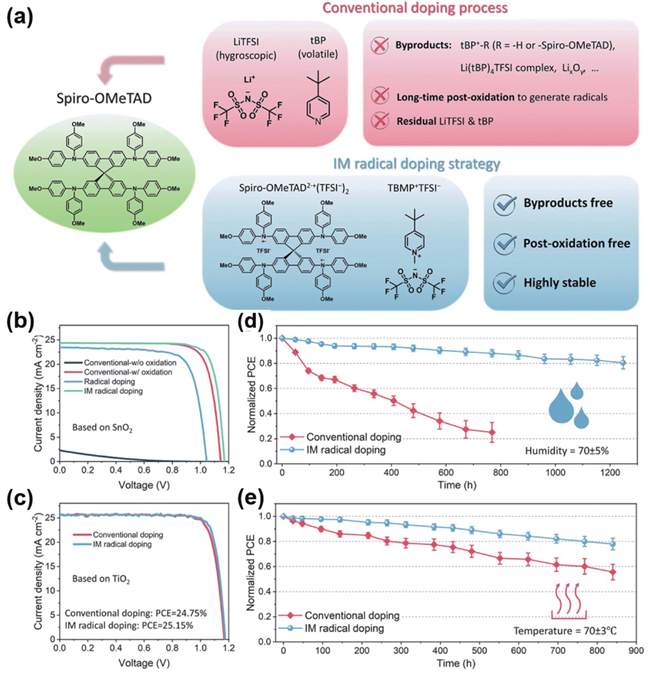Dongmei He, Shirong Lu, Juan Hou, Cong Chen, Jiangzhao Chen, Liming Ding. Doping organic hole-transport materials for high-performance perovskite solar cells[J]. Journal of Semiconductors, 2023, 44(2): 020202
Search by keywords or author
- Journal of Semiconductors
- Vol. 44, Issue 2, 020202 (2023)
![(Color online) (a) Comparison between the conventional and ion-modulated (IM) radical doping strategies. (b)J–V characteristics for SnO2-based PSCs (under different doping). (c)J–V curves for TiO2-based PSCs (conventional dopingvs IM radical doping). (d) Moisture stability for unencapsulated PSCs under 70 ± 5% humidity (conventional dopingvs IM radical doping). (e) Thermal stability for the unsealed devices at 70 ± 3 °C. Reproduced with permission[2], Copyright 2022, American Association for the Advancement of Science.](/richHtml/jos/2023/44/2/020202/jos_44_2_020202_f1.jpg)
Fig. 1. (Color online) (a) Comparison between the conventional and ion-modulated (IM) radical doping strategies. (b)J–V characteristics for SnO2-based PSCs (under different doping). (c)J–V curves for TiO2-based PSCs (conventional dopingvs IM radical doping). (d) Moisture stability for unencapsulated PSCs under 70 ± 5% humidity (conventional dopingvs IM radical doping). (e) Thermal stability for the unsealed devices at 70 ± 3 °C. Reproduced with permission[2], Copyright 2022, American Association for the Advancement of Science.
![(Color online) (a) Molecular structures for PTAA, F4TCNQ and LiHFDF. (b) Cross-sectional SEM image for PSCs with HFDF-HTL. (c)J–V curves for PSCs (Li-HTLvs HFDF-HTL). (d) Moisture stability for unsealed PSCs under AM1.5G radiation and ~50% RH (Li-HTLvs HFDF-HTL). (e) Thermal stability for the encapsulated devices with different HTLs under AM1.5G illumination at 85 °C. Reproduced with permission[16], Copyright 2022, American Association for the Advancement of Science.](/richHtml/jos/2023/44/2/020202/jos_44_2_020202_f2.jpg)
Fig. 2. (Color online) (a) Molecular structures for PTAA, F4TCNQ and LiHFDF. (b) Cross-sectional SEM image for PSCs with HFDF-HTL. (c)J–V curves for PSCs (Li-HTLvs HFDF-HTL). (d) Moisture stability for unsealed PSCs under AM1.5G radiation and ~50% RH (Li-HTLvs HFDF-HTL). (e) Thermal stability for the encapsulated devices with different HTLs under AM1.5G illumination at 85 °C. Reproduced with permission[16], Copyright 2022, American Association for the Advancement of Science.

Set citation alerts for the article
Please enter your email address



